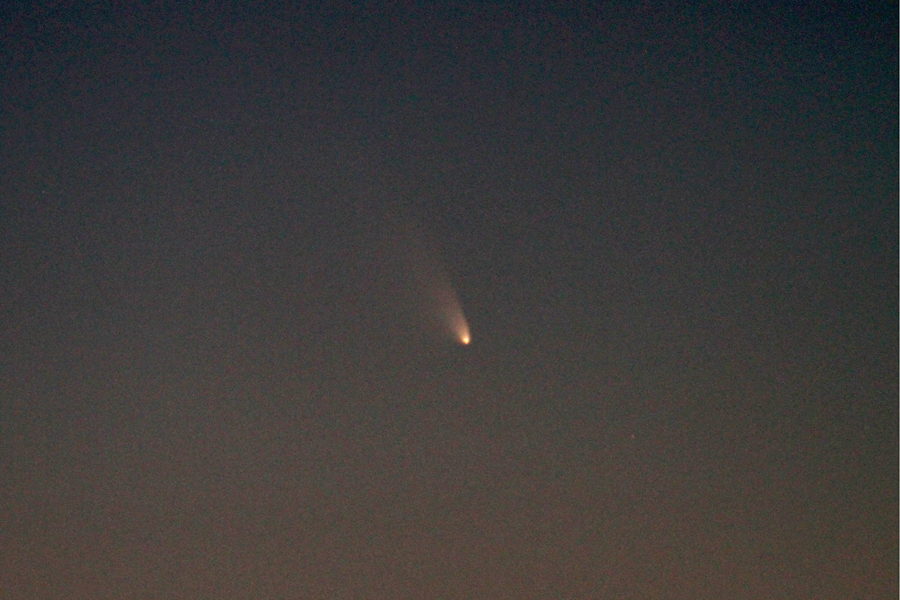See Comet Pan-STARRS Live in Webcast Saturday: How to Watch

Editor's note: The Virtual Telescope Project's planned live broadcast of Comet Pan-STARRS has been rescheduled for Saturday (March 16) because of cloudy conditions. The observatory's free webcast will begin Saturday at 1 p.m. EDT (1700 GMT).
An online observatory will broadcast live views of the Comet Pan-STARRS from Italy today (March 15), but only if weather allows.
The Virtual Telescope Project in Ceccano, Italy, will webcast views of Comet Pan-STARRS beginning at 1 p.m. EDT (1700 GMT). The comet is currently visible just after sunset to stargazers in the Northern Hemisphere, and can be seen low on the western horizon.
"We are so excited," astrophysicist Gianluca Masi, who runs the Virtual Telescope Project, told SPACE.com in an email. "A lot of people are waiting for this event!"
You can watch the Comet Pan-STARRS webcast on SPACE.com here.
The source webcast will also be available at the Virtual Telescope Project website.
Comet Pan-STARRS has been visible in the Northern Hemisphere evening sky since last week, though stargazers in the Southern Hemisphere were tracking the comet for months before it moved into the northern sky. The comet made its closest approach to the sun on Sunday (March 10), and was at its brightest at that time. [How to see Comet Pan-STARRS]
Get the Space.com Newsletter
Breaking space news, the latest updates on rocket launches, skywatching events and more!
But the position and timing of Comet Pan-STARRS in the evening sky has made it a challenge for some stargazers to see. The best time to see the comet is shortly after sunset, when bright evening twilight can interfere with the comet's glow. A clear viewing area with no obstructions, such as buildings or trees, is vital.
Veteran astrophotographers Imelda Joson and Edwin Aguirre snapped photos of Comet Pan-STARRS from Horn Pond in Woburn, Mass., on Wednesday (March 13).
"Initially, the comet was difficult to spot with the naked eye or binoculars in bright twilight, but as the sky got darker, it became quite obvious," Joson and Aguirre told SPACE.com. The duo also occasionally writes space photography columns for SPACE.com.
"However, one has to know exactly where to look to find the comet. Some casual observers might be impressed by the comet's appearance, but others might get disappointed," Joson added. "It really depends on one's level of expectation, observing skills and the amount of light pollution at his or her observing site."
On Tuesday (March 12), Comet Pan-STARRS was visible near the moon, amazing stargazers around the world who had clear views and good weather. The comet is slowing moving higher in the night sky, but it will also get dimmer, NASA scientists have said.
NASA's Stereo-B sun observatory also captured a video of Comet Pan-STARRS with the Earth and planet Mercury this month.
"The comet should remain visible to the naked eye through the end of March," NASA officials said Thursday in a video update.
Comet Pan-STARRS is officially known as C/2011 L4 (PANSTARRS) and was discovered by a team of astronomers using the Panoramic Survey Telescope & Rapid Response System (Pan-STARRS) in Hawaii. The comet likely took millions of years to make its way into the inner solar system from the distant Oort Cloud at the edge of the solar system, but after this first swing around the sun it should settle into an 110,000-year orbit, scientists have said.
Pan-STARRS is one of several comets to grace the night sky in 2013. Earlier this year, Pan-STARRS and the Comet Lemmon were visible at the same time from the Southern Hemisphere.
In late November, the incoming sungrazer Comet ISON will make its closest approach to the sun. Comet ISON was discovered by amateur astronomers in Russia in September 2012 and could be a potentially dazzling "comet of the century" in November, but it could also fizzle out — it's too early to tell, NASA scientists have said.
Editor's note: If you snap an amazing photo of Comet Pan-STARRS in the night sky, or any other celestial object, and you'd like to share for a possible story or image gallery, please send images and comments, including location information, to managing editor Tariq Malik at spacephotos@space.com
Email Tariq Malik at tmalik@space.com or follow him @tariqjmalik and Google+. Follow us @Spacedotcom, Facebook and Google+. Original article on SPACE.com.
Join our Space Forums to keep talking space on the latest missions, night sky and more! And if you have a news tip, correction or comment, let us know at: community@space.com.

Tariq is the Editor-in-Chief of Space.com and joined the team in 2001, first as an intern and staff writer, and later as an editor. He covers human spaceflight, exploration and space science, as well as skywatching and entertainment. He became Space.com's Managing Editor in 2009 and Editor-in-Chief in 2019. Before joining Space.com, Tariq was a staff reporter for The Los Angeles Times covering education and city beats in La Habra, Fullerton and Huntington Beach. In October 2022, Tariq received the Harry Kolcum Award for excellence in space reporting from the National Space Club Florida Committee. He is also an Eagle Scout (yes, he has the Space Exploration merit badge) and went to Space Camp four times as a kid and a fifth time as an adult. He has journalism degrees from the University of Southern California and New York University. You can find Tariq at Space.com and as the co-host to the This Week In Space podcast with space historian Rod Pyle on the TWiT network. To see his latest project, you can follow Tariq on Twitter @tariqjmalik.











